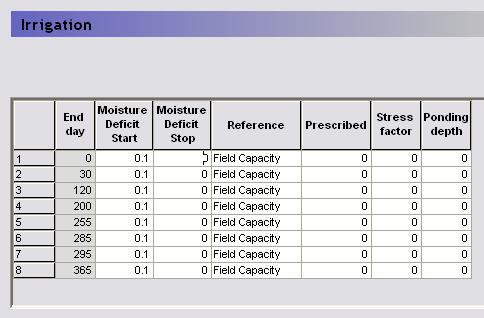
In the irrigation module the amount of irrigation applied can be driven by the amount of water demanded by the crop. That is, in drier periods more irrigation water is required, so more irrigation is applied.
In the Irrigation demand dialogue, if you specify that the Vegetation Property file should be used for the demand calculations, then the demand values will be read from the vegetation file specified in the Vegetation (V1 p. 245) dialogue.
Further, in the irrigation module, you specify the type of demand calculation:
· User specified
· Maximum allowed deficit
· Crop stress factor
· Ponding depth
In the Irrigation dialogue of the Vegetation properties file,

you must specify a value for each of these demand types. Although, those that will not by used, may be left at the default values.
Maximum allowed deficit - If irrigation is handled automatically based on the actual moisture content in the soil, the soil moisture deficits are the deficits at which irrigation is going to start and stop. The soil moisture deficit is defined relative to the plant available water content in the root zone, which is the difference between a reference moisture content and the moisture content at wilting point. If, for example, the reference moisture content is the moisture content at field capacity and irrigation should start when 60 % of the available water in the root zone is used and cease when field capacity is reached, the value in the start column should be 0.6, the value in the stop column should be 0 and the reference input should be “field capacity”.
User specified - Alternatively, the irrigation amount applied in each crop stage can simply be prescribed.
Crop stress factor - The crop stress factor is the minimum allowed fraction of the reference ET that the actual ET is allowed to drop to before irrigation starts . That is, the minimum allowed (Actual ET)/(Reference ET) relationship This should be a value between 1 and 0.
Ponding depth - When using this option, the demand will be equal to the difference between the actual ponding depth and specified ponding depth. The option is typically used for modelling irrigation of paddy rice.
Thus:
· Moisture Deficit Start - the maximum allowable moisture deficit below the specified reference level. Irrigation will start at this level.
· Moisture Deficit Stop - This is the minimum allowable moisture deficit below the specified reference level. If irrigation takes place it will stop at this level;
· Reference - The reference moisture content. It can be chosen as either saturation or field capacity.
· Prescribed - This is the value used for the irrigation demand when ’User specified’ is chosen in the Irrigation Demand (V1 p. 259) dialogue.
· Stress Factor - This is the minimum allowed (Actual ET)/(Reference ET) relationship This should be a value between 1 and 0.
· Ponding Depth - Irrigation will stop when the ponding depth reaches this value.